#migratory birds
Text
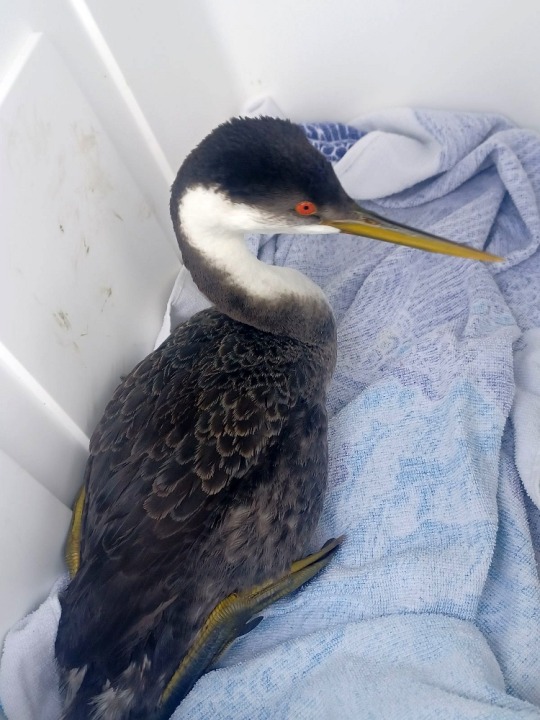
Today is apparently ANGRY STABBY BIRB DAY.
I was taking a walk on the boardwalk out near Bolstadt in Long Beach, when I came across this western grebe (Aechmophorus occidentalis) stranded on the path ahead of me. It looked alert and uninjured, so chances were just that it couldn't take flight off of the hard surface, but I called Peninsula Wild Care anyway to see if they wanted to bring it in for a checkup.
They quickly coordinated a couple of volunteers to meet me nearby, and I needed to get the grebe out of the way since a lot of people walk their dogs there and not all of them are on leashes. I figured okay, this is a relatively small bird, not as big as the muscovies I've carted around on the farm, and it seems calm, right?
NOPE. As I tried to gently reach for the grebe it turned from a calm, if confused pile of feathers on the decking to Stabby McStabberson, and I very nearly got jabbed and nipped a few times by a long, pointy beak attached to a surprisingly agile and very much NOT happy bird. I ended up having to take my hoodie off and dropping it over the entire grebe, and only when the lights were out could I bundle it up and carry it over to the meeting place.
Since it was pretty energetic, not obviously sick or injured, and its body condition felt decent (at least through the hoodie) I'm hoping it's going to get released soon enough after a checkup and a nice meal of fish. Many waterbirds have a lot of trouble taking off from hard surfaces because their feet are so far back on their bodies--which is great for swimming and water takeoffs, but not so helpful on land. If the bird had stayed stranded there they could have been injured or killed by another animal, or ended up dehydrated.
So let's hear it for Stabby the Angry Grebe, and wish them a good release back into the wild!
#grebe#western grebe#birds#birbs#birdblr#wildlife#animals#dinosaurs#avian#avian dinosaurs#Washington#Pacific Northwest#PNW#animal rescue#animal rehab#wildlife rehab#ecology#nature#conservation#migratory birds
845 notes
·
View notes
Text
"A coral reef with flourishing marine life has been discovered off Ecuador's Galapagos Islands.
A scientific expedition traced the 1.2-mile-long (2km) reef to the top of an underwater mountain formed by volcanic activity - 400m (1,300ft) deep.
Ecuador's environment minister, Jose Davalos, said the exploration team "found the first totally pristine coral reef... on the summit of a submarine mountain".
The previously unknown underwater colony comes as a surprise to scientists, who believed only one reef existed in the volcanic archipelago - Wellington - along the coast of the tiny Darwin Island.
Reefs in the area were severely degraded during El Niño weather in 1982-83 when the ocean surface warmed to devastating levels.
However, the newly discovered reef survived the event and has more than 50% living coral.
Mr. Davalos tweeted: "Galapagos surprises us again."

Senior marine researcher at the Charles Darwin Foundation and expedition participant, Stuart Banks, said: "This is very important at a global level because many deepwater systems are degraded."
He added the coral dated back several thousand years.
Ecuador expanded the Galapagos marine reserve by more than 20,000 square miles last year to protect endangered migratory species between the archipelago and Cocos Island in Costa Rica.
Many endangered animals live on the islands including giant tortoises, albatrosses and cormorants."
-via Sky News UK, 4/18/23
#coral#coral reef#underwater#galapagos#ecuador#costa rica#marine science#endangered species#migratory birds#good news#hope
1K notes
·
View notes
Text

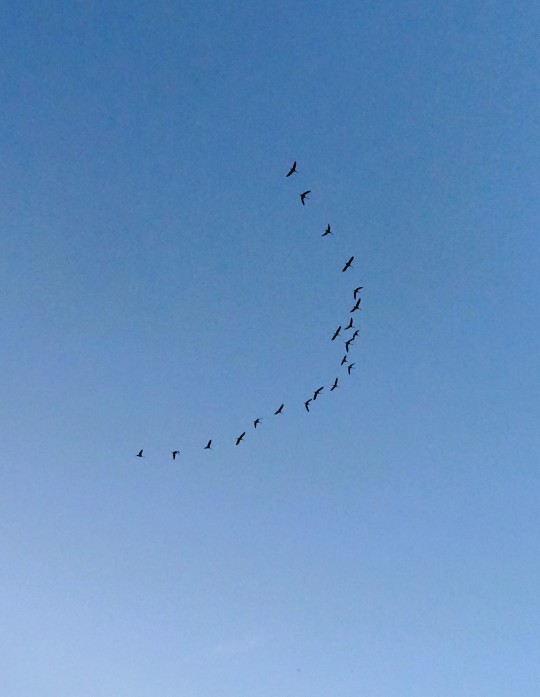
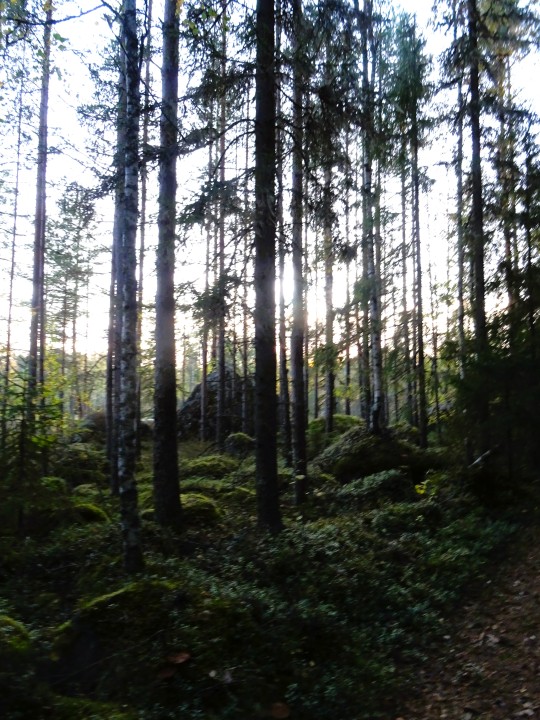




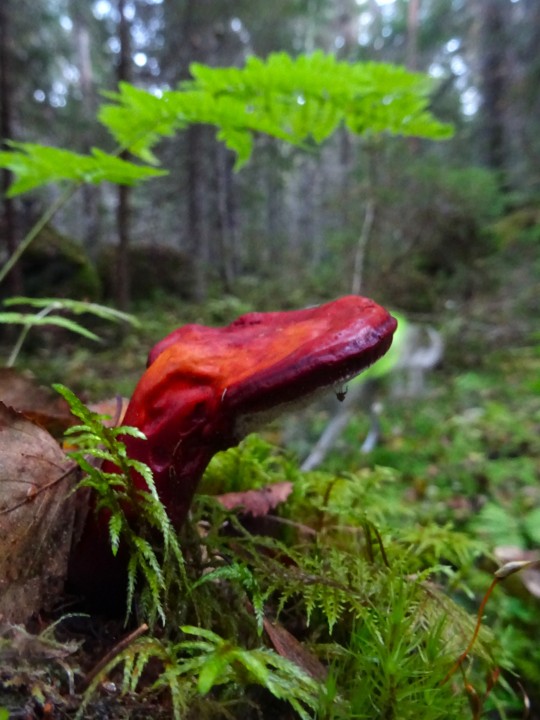

Some pics from my walk in the woods tonight.
#photography#nature photography#mushroom photography#mushrooms#fungi#wild fungi#migratory birds#cranes#forest photography#mushroomcore#forestcore#goblincore#gremlincore
180 notes
·
View notes
Text
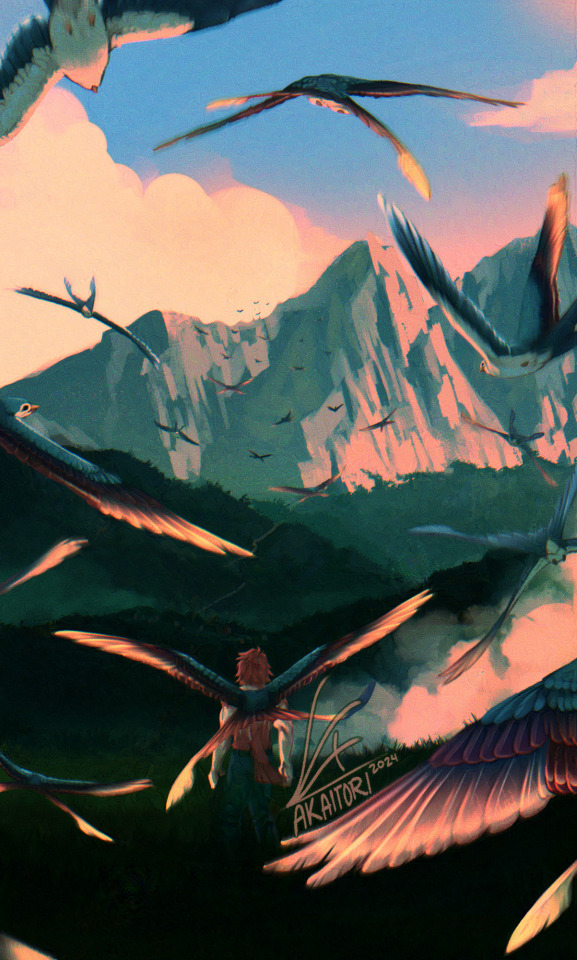
Migratory Birds
I belonged with you, once.
Big thanks to the folks that joined the stream for this one :)
#digital art#sparrows#migratory birds#fantasy#bird art#wings#feathers#illustration#original character#vagrant skies
16 notes
·
View notes
Text
Through night and moisture
wild geese go south
crying in painful glory.
I feel like writing a dark story:
Them carrying away
on their two white wings
I don’t know where,
I don’t know what
of my soul’s dearest things.
Desanka Maksimović - (Селице) Migratory Birds
Кроз ноћ и влагу
дивље се гуске селе југу
и болно кричу.
Осећам жељу да мутну неку
напишем причу:
како односе оне собом
на крила своја бела два
из душе моје драго нешто,
а не знам куда,
и не знам шта.
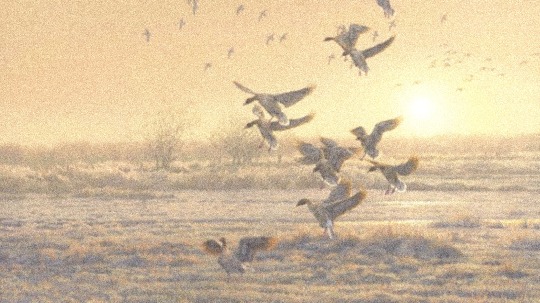
50 notes
·
View notes
Text
This morning I found a perfectly intact body of an American Woodcock outside my building. There was a long, sweeping dent in the soft ground by its head, which means it must have thrashed its head for a while before eventually dying. I have no doubt it died from crashing into a window.
I'm a birder, and the American Woodcock wasn't on my year list yet. They're beautiful birds, even in death. It's upsetting that my first woodcock this season is a dead one.
It's migration season, and American Woodcocks fly low, which means even a relatively short apartment building can mean death for them. The lights from the windows at night confuses them and so many other migratory birds.
Please, and especially if you live in a city that is along a migration route, block your windows at night with blackout curtains. Every year, thousands of migratory birds die from building collisions. It's not that hard to save them.
69 notes
·
View notes
Text
Just saw the first returning migratory birds of this spring. It's so weird how happy a couple of swans can make me :')
#migratory birds#swans#was standing at a bus stop and they flew over#great start for the day#maybe spring will come#I live in Finland for context
7 notes
·
View notes
Text
The Great Salt Lake is drying up and the Republican government of Utah is doing little to save it. They constantly cave to the usual groups: agricultural interests, mining, homeowners who like spacious lawns in an arid region, and big industry.
The largest saltwater lake in the western hemisphere has been steadily shrinking, as more and more water has been diverted away from the lake to irrigate farmland, feed industry and water lawns. A megadrought across the US south-west, accelerated by global heating, has hastened the lake’s demise.
Unless dire action is taken, the lake could decline beyond recognition within five years, a report published early this year warned, exposing a dusty lakebed laced with arsenic, mercury, lead and other toxic substances.The resulting toxic dustbowl would be “one of the worst environmental disasters in modern US history”, the ecologist Ben Abbott of Brigham Young University told the Guardian earlier this year.
Despite such warnings, officials have failed to take serious action, local groups said in their lawsuit, which was filed on Wednesday. “We are trying to avert disaster. We are trying to force the hand of state government to take serious action,” said Brian Moench of the Utah Physicians for a Healthy Environment, one of the groups suing state agencies.
“Plaintiffs pray that this Court declare that the State of Utah has breached its trust duty to ensure water flows into the Great Salt Lake sufficient to maintain the Lake,” reads the lawsuit, which was brought by coalition that includes Earthjustice, the Utah Rivers Council, the Center for Biological Diversity and the Sierra Club, among others.
Political pressure has not been very effective in a state dominated by Republicans. The state's response is lukewarm at best. That's in addition to bizarre proposals.
The state’s Republican governor, Spencer Cox, has suspended new claims to water in the Great Salt Lake basin and appointed a commissioner to oversee response to the lake crisis. Last year, Utah’s legislature passed several conservation measures, including a $40m trust to support lake preservation projects. But Abbott and his colleagues, who authored a sobering report on the lake in January, found that those measures increased flows to the lake by just 100,000 acre feet in 2022. About 2.5m acre-feet a year of water will need to flow into the lake to bring it to a healthy level, the researchers estimated.
That water will likely have to come at the expense of agriculture, which takes in about three-quarters of the water diverted away from the lake to grow mostly alfalfa and hay. Cities and mineral extraction operations each take up another 9% of diverted water.
But wresting water away from agriculture is politically complicated. Officials have explored propositions to pay farmers to fallow land and use less water, though such proposals have yet to gain much tractions.
Lawmakers have also offered up a series of out-of-the-box solutions – including cloud seeding, which uses chemicals to prompt more precipitation – or building a giant pipeline from the Pacific Ocean.
Seriously, a pipeline from the Pacific Ocean? This is a classic idiotic GOP way to deal with an environmental catastrophe which doesn't get to the root of the problem.
Already, the lake has lost 73% of its water and 60% of its surface area, and is becoming saltier, threatening native flies and brine shrimp. A diminished lake may be unable to support the more than 10 million migratory birds that stop over in the region. A white pelican colony recently abandoned a nesting site on the lake, potentially due to declining water levels.
“In addition to the millions of people who live here, so many plants and animals depend on the lake,” said Deeda Seed, Utah campaigner at the Center for Biological Diversity. “The health of northern Utah’s entire population depends on the Great Salt Lake’s survival and I hope this lawsuit can help save it.”
^^^ emphasis added
Yep, take their asses to court to save the body of water which gave the state's largest city its name.
#utah#great salt lake#water levels#diversion of water#the environment#migratory birds#white pelicans#brine shrimp#republicans#utah state government#spencer cox#deeda seed#brian moench#ben abbott#earthjustice#utah rivers council#the sierra club#center for biological diversity#utah physicians for a healthy environment
13 notes
·
View notes
Text
Servus!

Today i offer you a stork and it's offspring which i call " Overexposed chicken " from July
This time i drew this while sitting in a ditch. Left my backpack by the road and people passing by were confused because they didn't see me xD
They're drawn real quick but i think they're pretty :/ did it to appreciate the passing of the time ( summer )
#illustration#crayon art#drawing#drawing from nature#ornitology#birds#storks#migratory birds#sketch#summer#jubenile bird#baby stork#micron pen#micron#🪶
6 notes
·
View notes
Text

Flamboyant Camouflage
Sky Edwards
2023
Canon R7
Canon EF 100-400 L IS USM
Rainbow bee eater, Merops ornatus
#rainbow bee eaters#rainbow#birds#colourful birds#australian birds#australian wildlife#wildlife photography#bird photography#merops ornatus#migratory birds#animal photography#australian animals
3 notes
·
View notes
Photo

Water is fundamental to life on our planet. Migratory birds depend on it to survive.
Yet, pollution, water scarcity & the climate crisis are having a direct impact on the aquatic ecosystems these species rely on.
Saturday’s World Migratory Bird Day highlights the need to address human activities that put migratory birds at risk. https://lnkd.in/gZHFyBq
#birds#nature#osprey#swallow#meadowlark#hummingbird#albatross#puffin#kingfisher#duck#plover#pelican#crane#dove#stained glass style art#blue#green#water#migratory birds
13 notes
·
View notes
Text

Barn owl (Tyto alba) secondary feather, right wing. Scappoose, OR, 7-21-23.
#barn owl#owl#owls#birds#bird#raptors#ornithology#feather#feathers#migratory birds#nature#wildlife#animals
89 notes
·
View notes
Text
"There’s something deeply comical about suggesting that seagulls are smart enough to wait for you to look away before stealing your french fries, but dumb enough to fly into wind turbine blades.
A two-year study on the interactions of several seabird species at an offshore wind farm found that not a single case of birdstrike was recorded over the study period or in the 10,000 videos taken.
Looking at herring gulls, gannets, kittiwakes, and great black-backed gulls, Swedish state wind company Vattenfall found that most of the birds maintained a 50 to 230-yard distance between themselves and the radius of the spinning turbines.
“This is the first time that any kind of bird species has been studied this closely and in detail at an offshore wind farm,” said study author Henrik Skov. “And these birds are really good at avoiding the turbines. Now we need studies on more varieties.”
The study was conducted on a wind farm consisting of 11 offshore turbines near Aberdeen, Scotland. It used radar surveys and mounted video cameras to gather data.
Why these seabirds avoided the turbines could be down to the individual species observed since other studies have shown seabirds tend to rank high in offshore wind turbine mortality, and of medium risk for land-based wind turbine mortality.
Skov also offered that it could be the turbines are, for one reason or another, outside of prominent flight corridors, and therefore aren’t where birds have historically flown either for migration and nesting purposes, or feeding.
The study is a big milestone in scientists’ attempts to learn how and where to build wind turbines so that they don’t interfere with birds’ flight patterns. If there is something in the data of this study or future observations that could reveal the secret as to why there was no mortality at the Aberdeen wind farm, it could mean that hundreds of thousands of birds could be saved in the future."
-Good News Network, 3/31/23
#wind farm#wind turbines#renewable energy#birds#migratory birds#seabirds#conservation#good news#hope
426 notes
·
View notes
Text
Protect Hartlen Point is a community-led movement to protect the thriving ecosystem of Hartlen Point and surrounding community of Eastern Passage in Nova Scotia. The Department of National Defence (DND) is looking at building a Weapons Systems Testing Facility on the coastal land.
Hartlen Point is incredibly important for local and migratory wildlife, hosting hundreds of thousands of birds each year of more than three-hundred species. It is a critical stopover for migrating birds to feed and rest. The headland is home to other wildlife including bobcat, coyote, rabbit, deer, and the star-nosed mole, to name just a few. In terms of marine life, from the hermit crabs in the tidal estuary to the harbour seal colony near shore, it is a thriving marine ecosystem.
As clearly stated by DND, the $65 million, 9000m weapons systems testing facility will emit high powered radio frequencies that pose significant risk to humans, birds, and wildlife that are within the broad range of emissions. This includes the provincial crown land intertidal shoreline area of Hartlen Point and the nearshore waters of Hartlen Point.
The community has a petition which lays out the full story and what they are currently asking for here. They have a linktree here with information about the local ecology and community, as well as links to write to those with the power to interefere with the current plans.
#protect hartlen point#signal boost#important#ecology#conservation#environment#canada#nova scotia#migratory birds#petition#action
50 notes
·
View notes
Text

Birds of the Americas - the American white pelican.
#vintage illustration#science#zoology#biology#ornithology#birds of the americas#birds#pelican#american white pelican#engravings#nature art#the natural world#nature#pelecanus erythrorhynchos#water fowl#migratory birds
3 notes
·
View notes
Text

C. Vecchio Photo of a Varied Thrush.
World Migratory Bird Day
What would spring be like without the return of migratory birds? One sure sign of spring at Mount Rainier is the sound of the Varied Thrush (Ixoreus naevius). Their distinctive calls have a long, rising whistle-like note. This robin-sized bird migrates early in the season to spend the summer in Mount Rainier’s forests. Another common migratory bird is the Swainson’s Thrush (Catharus ustulatus). They winter in Central and South America, flying more than 4,000 miles each way during their migration.
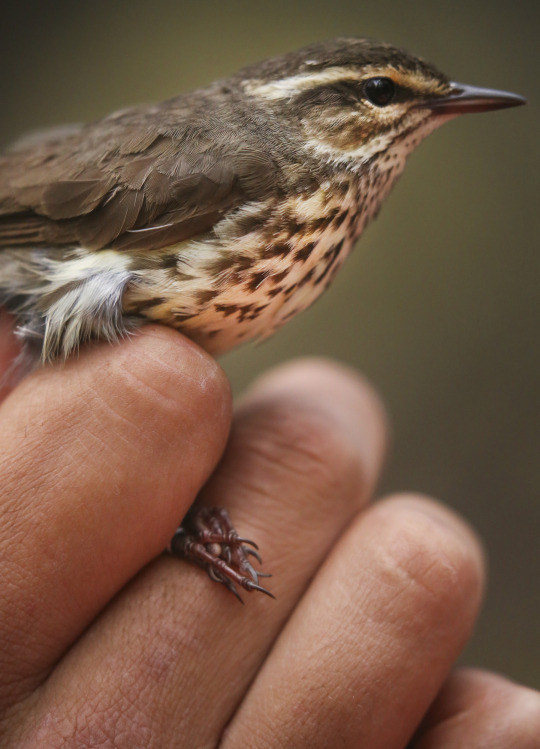
NPS/E. Mesner Photo of an avian ecologist holding a Swainson’s Thrush.
Migratory birds (as well as resident birds) are tracked at the park’s MAPS (Monitoring Avian Survival and Productivity) bird banding station, one of more than 1,200 stations in North America used to monitor bird populations, including migration patterns. The MAPS project is run by park ecologists (with the required permits) and serves as an entry point for many student interns interested in field biology from across the country. You can help monitor migratory birds, too! If you observe a banded bird, please call to report it at 1-800-327-BAND.
Learn more about bird banding at Mount Rainier National Park at https://go.usa.gov/xu7mk.
~kl
#World Migratory Bird Day#mount rainier national park#migratory birds#birds#ecology#migration#varied thrush#swainson's thrush#wildlife
69 notes
·
View notes